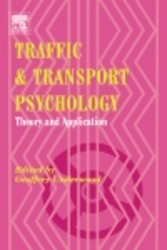Search and Find
Service
Cover Page
1
Traffic and Transport Psychology: Theory and Application
4
Copyright Page
5
Contents
6
Preface
12
Prologue
14
Chapter 1. Traffic Psychology in a (New) Social Setting
16
Vulnerable Road Users I: Pedestrians and Cyclists
28
Chapter 2. Using Epidemiological Data to Address Psychological Questions about Pedestrian Behaviour
30
Chapter 3. Rural and Urban Children's Understanding of Safety and Danger on the Road
40
Chapter 4. A Thematic Analysis of Children and Young Adults' Perceptions of Roadway Risk
50
Chapter 5. Are Differences in Children's Travel Reflected in Their Cognitive Maps?
62
Chapter 6. Criteria for Cyclists' Everyday Route Choice
76
Vulnerable Road Users II: Older Road Users
90
Chapter 7. The Elderly Pedestrian and Social Representations
92
Chapter 8. Elderly Drivers' Hazard Perception and Driving Performance
104
Chapter 9. Assessment and Decision Criteria for Driving Competence in the Elderly
114
Chapter 10. The Rookwood Driving Battery and the Older Adult
128
Vulnerable Road Users III: Novice Drivers
140
Chapter 11. What Do Novice Drivers Learn during the First Months of Driving? Improved Handling Skills or Improved Road User Interaction?
142
Chapter 12. "TRAINER" Project: Pilot Applications for the Evaluation of New Driver Training Technologies
154
Chapter 13. Profile of the British Learner Driver
170
Chapter 14. Effects of Lowering the Age Limit for Driver Training
184
Emotion and Personality
192
Chapter 15. The Role of Attributions and Anger in Aggressive Driving Behaviours
194
Chapter 16. Developing the Driving Anger Scal
204
Chapter 17. Effects of Emotions on Optimism Bias and Illusion of Control in Traffic
216
Chapter 18. Big Five Personality Traits as the Distal Predictors of Road Accident Involvement
228
Automation and Information Systems
242
Chapter 19. Mind Over Matter: Who's Controlling the Vehicle and How do We Know
244
Chapter 20. Adaptation Effects in an Automated Car-Following Scenario
256
Chapter 21. Evaluation of a DGPS Driver Assistive System for Snowplows and Emergency Vehicles
270
Chapter 22. ADAS' Acceptance and Effects on Behaviour: the Consequences of Automation
286
Chapter 23. Age, Previous Knowledge, and Learnability of Driver Information Systems
292
Chapter 24. Automated Driving Does not Work without the Involvement of the Driver
306
Chapter 25. The Role of Expectations in Interaction Behaviour between Car Drivers
316
Driving Performance I: Control and Workload
328
Chapter 26. Cross Modal Effects in Transportation
330
Chapter 27. Regulation of Speed and Time-Headway in Traffic
340
Chapter 28. Speed, Traffic Complexity and Visual Performance: A Study on Open Road
352
Chapter 29. Effects of Motorway Lighting on Workload and Driving Behaviour
368
Chapter 30. A Study of Conversation Performance Using Mobile Phones
382
Chapter 31. Traffic Psychology Theories: towards Understanding Driving Behaviour and Safety Efforts
396
Driving Performance II: Perception and Awareness
408
Chapter 32. Driver's Perception of Self-Explained Road Infrastructure and Architecture
410
Chapter 33. The Effect of Vehicle Navigation Systems on the Formation of Cognitive Maps
420
Chapter 34. Mental Representation of Traffic Signs: Role of Sign Complexity and Semantic Information
432
Chapter 35. Professional Driver Training and Driver Stress: Effects on Simulated Driving Performance
444
Chapter 36. Does Time Slow down in a Car Crash? Danger, Time Perception and Speed Estimates
456
Chapter 37. Driving without Awareness
468
Chapter 38. Prophylactic Naps Can Reduce Car Accidents Risk in Shift-Workers
484
Violation and Rehabilitation
498
Chapter 39. Drivers and Traffic Laws: a Review of Psychological Theories and Empirical Research
500
Chapter 40. Why Do Drivers Speed?
518
Chapter 41. Effects of Speed Cameras on Driver Attitude and Behaviour
526
Chapter 42. What Shall We Do about Speeding—Education?
534
Chapter 43. Ways to Rehabilitate Drunken Drivers in Germany—Recruiting of Clients, Rehabilitation Programs, Evaluation
542
Chapter 44. Setting up and Assessing a Commitment Procedure in Rehabilitation Training Courses for Traffic Regulation Offenders in France
552
Travel Demand Management and Travel Mode Choice
562
Chapter 45. Changes of Private Car Use in Response to Travel Demand Management
564
Chapter 46. Childhood Influences on Adult Travel Mode Choice
586
Chapter 47. Temporary Structural Change: a Strategy to Break Car-Use Habit and Promote Public Transport
598
Epilogue
606
Chapter 48. Traffic Psychology and Road Safety: Separate Realities
608
Name Index
614
Subject Index
628
All prices incl. VAT












